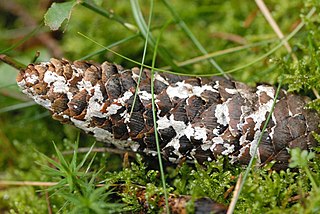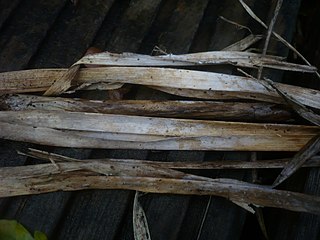Related Research Articles

Oxyporus is a genus of polypore fungi in the family Schizoporaceae. An individual family Oxyporaceae was described for the genus. A number of species in this genus are plant pathogens, causing a white rot. The genus is widely distributed.

Phanerochaete is a genus of crust fungi in the family Phanerochaetaceae.

Atheliaceae is a family of corticioid fungi placed under the monotypic order Atheliales. Both the order and the family were described by Walter Jülich in 1981. According to a 2008 estimate, the family contains 20 genera and approximately 100 species. However, many genera formerly considered to belong in the Atheliaceae have since been moved to other families, including Amylocorticiaceae, Albatrellaceae, and Hygrophoraceae. Despite being a relatively small group with inconspicuous forms, Atheliaceae members show great diversity in life strategies and are widespread in distribution. Additionally, being a group strictly composed of corticioid fungi, they may also provide insights on the evolution of fruiting body forms in basidiomycetes.

The Meruliaceae are a family of fungi in the order Polyporales. According to a 2008 estimate, the family contains 47 genera and 420 species. As of April 2018, Index Fungorum accepts 645 species in the family.

The Phanerochaetaceae are a family of mostly crust fungi in the order Polyporales.
Candelabrochaete is a genus of crust fungi in the family Phanerochaetaceae.
Roseograndinia is a fungal genus in the family Phanerochaetaceae. It is a monotypic genus, containing the single crust fungus species Roseograndinia rosea, recorded from tropical east Africa and from New Zealand.
Amethicium is a fungal genus in the family Phanerochaetaceae. A monotypic genus, it contains the single species Amethicium rimosum, a crust fungus first reported from Tanzania in 1983. Amethicium is primarily characterized by its purple fruit body and a dimitic hyphal system. The felt-like tissue layer covering the substrate comprises a thin layer of densely intertwined skeletal hyphae.

Hydnophlebia is a genus of five species of toothed crust fungi in the family Meruliaceae. All species are wood-decay fungi that cause a white rot.
Pirex is a fungal genus in the family Meruliaceae. It is a monotypic genus, containing the single crust fungus Pirex concentricus. It is found in the Pacific Northwest region of North America, where it causes a white rot in woody hardwood and conifer debris generated by timber harvesting.
Uncobasidium is a genus of two species of crust fungi in the family Meruliaceae. The genus was circumscribed by mycologists Kurt Hjorstam and Leif Ryvarden in 1978 with the European fungus U. luteolum as the type species. The South American species U. roseocremeum was added to the genus in 2012. The distinguishing feature of Uncobasidium is the basal hook in the basidium.

Dentocorticium is a genus of six species of poroid fungi in the family Polyporaceae. The genus was revised in 2018, with several new species added and some older species transferred to other genera, based on phylogenetic analyses.

Epithele is a genus of crust fungi in the family Polyporaceae.

Skeletocutis is a genus of about 40 species of poroid fungi in the family Polyporaceae. The genus has a cosmopolitan distribution, although most species are found in the Northern Hemisphere. It causes a white rot in a diverse array of woody substrates, and the fruit bodies grow as a crust on the surface of the decaying wood. Sometimes the edges of the crust are turned outward to form rudimentary bracket-like caps.
Coniophoropsis is a fungal genus in the family Coniophoraceae. It is a monotypic genus, containing the single species Coniophoropsis obscura, found in Argentina. Both the genus and the species were described in 1986 by mycologists Kurt Hjorstam and Leif Ryvarden.
Crustodontia is a fungal genus of uncertain familial placement in the order Polyporales. The genus was circumscribed in 2005 to contain the crust fungus Crustodontia chrysocreas. This species was originally described as Corticium chrysocreas by Miles Berkeley and Moses Ashley Curtis in 1873. Their description was as follows: "Subiculum bright yellow, thin; hymenium immarginate pallid, or yellow tinged with tawny." Crustodontia has a monomitic hyphal system, meaning it contains only generative hyphae, and these hyphae have clamp connections.
Globuliciopsis is a genus of two species of crust fungi in the order Polyporales that are found in Central and South America.
Mycoacia rubiginosa is a species of toothed crust fungus in the family Meruliaceae. It was described as a new species in 2004 by mycologists Kurt Hjortstam and Leif Ryvarden. The type collection was made in Sierra Nevada de Santa Marta, in Magdalena, Colombia, where the fungus was found growing on dead hardwood. It is known only from the type locality. Fruit bodies of M. rubiginosa are distinguished by their reddish colour, and spines up to 3 mm (0.12 in) long. The hyphal system is monomitic, containing only generative hyphae. The spores are ellipsoid, smooth, thin-walled and translucent, with dimensions of 4–4.5 by 2.5–2.75 µm.
Grammothele bambusicola is a poroid crust fungus in the family Polyporaceae that is found in Asia. It was described as new to science in 1984 by Norwegian mycologist Leif Ryvarden.
Uncobasidium luteolum is a species of crust fungus in the family Meruliaceae, and the type species of genus Uncobasidium. The holotype was collected in Øvre Dividal National Park, in Målselv (Norway), where it was growing on Salix. The fungus has a monomitic hyphal system, with individual hyphae measuring 2.5–4 μm and having a clamp connection and oily refractive contents. The basidia are four-sterigmate, measure 30–50 by 8 µm, and feature a hook-shaped protuberance. Its spores are ellipsoid to obovate in shape, measuring 9 by 6 µm. Uncobasidium roseocremeum, found in South America, differs microscopically from U. luteolum in its larger, spherical spores, and the presence of encrusted hyphidia.
References
- 1 2 Hjorstam, K. (1995). "Two new genera and some new combinations of corticioid fungi". Mycotaxon. 54: 183–193.
- 1 2 Hjortstam, K.; Ryvarden, L. (1986). "Some new and noteworthy fungi (Aphyllophorales, Basidiomycetes) from Iguazu, Argentina". Mycotaxon. 25 (2): 539–567.